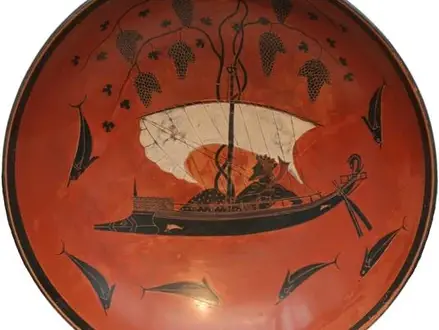Title of Artwork: “Dionysus Cup”

Artwork by Exekіas
Ancient Greek Pottery
Year Created 530BC
Summary of Dionysus Cup
Known as the Dionysus Cup, this kylix (drinking cup) dates back to 540–530 BC, making it one of the most well-known vase paintings of the ancient Greeks at the time. One of Exekias’ masterpieces, and a major part of the Staatliche Antikensammlungen in Munich’s collection, this piece is a black-figure Attic potter’s masterpiece.

All About Dionysus Cup
1.36-inch-tall, 30-inch-wide, and 13.6-inch-wide cups are available. A few large sherds make up the entirety of the object. The tondo, the image on the inside of the cup, occupies nearly all of its interior space. A sailing ship is depicted in the centre, moving from left to right.
While the rudder is clearly visible at the back, the ship’s prow is adorned with an animal head. There is a large statue of Dionysus, the god of wine, inside the ship. Unlike the other parts of the image, the sail in the black figure style is painted white. With three large clusters on one side and four on the other side, vines grow from the mast.

Two dolphins swim to the right, three to the left, and a fourth dolphin can be found on both sides of the ship. It’s possible that the dolphins are swimming around the ship, even though this isn’t a realistic perspective. Dolphins, like the vine, represent Dionysos.
Additionally, there are numerous finer details that can be seen in the image’s outline. The side of the ship has been etched with two dolphins, each about the same size. God is crowned with ivy and holds a cornucopia in his hand, with long hair and beard. His tunic has a beautiful design on it. Six warriors guard each of the handles on the outside. It features a stylized face between the handles with large eyes and a tiny nose.
For the interior image, two interpretations have been put forth by the author. There is a common belief that the seventh Homeric Hymn refers to Dionysus’ kidnapping by Etruscan pirates, who were unaware of his identity. The gods make them think they’re something they’re not, and then they turn into dolphins when they jump in.
As an alternative, it is possible that Dionysus’ arrival at the Athens Anthesteria is depicted. Patroclus and Achilles’ corpses are depicted in the images around the handles, with the naked Patroclus depicted.
The cup features a wide range of technological advancements. As a potter, Exekias reworked pre-existing forms into something entirely new. With a thicker foot, ring around the stem and a wide bowl, the so-called Cup type A quickly became the most popular form. Exekias may have introduced the “eye-cup” motif with this piece.
It became less common as time went on. Similar to the other innovations, the decoration around the handles was novel, but it failed to gain traction. Notably imitated by the Penthesilea Painter in time, but not commonly seen, was a tondo that nearly filled the inside of the cup.
The gorgoneion tondo was a common decoration on the inside of a cup before this change in practice. The technique of Intentional Red, in which the background was made of an intense, dark red clay, was also new, but it was only used experimentally for a few years and then only rarely. The cup is the earliest example here, too. It’s just a ship and some grapes with no other reference to the cup’s horizon line.
Information Citations
En.wikipedia.org, https://en.wikipedia.org/.























